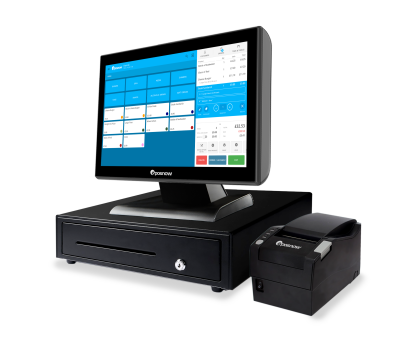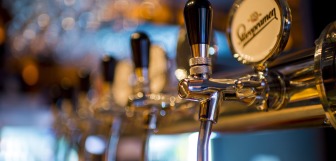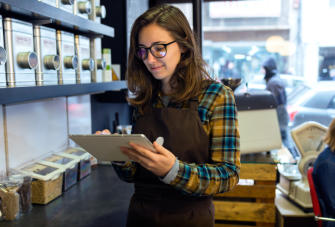Bar pricing guide to price alcoholic drinks effectively
They say, “Price is what you pay. Value is what you get.” While Warren Buffet wasn’t exactly talking about cocktails, he might as well have been.
In the bar business, a drink isn’t just a drink. It’s a story. An experience. A reason to leave the house. And yet, that story is often told (or cut short) by the numbers on a menu. Drink prices are like invisible hand shaping the success or failure of every bar, from the grungiest dive to the swankiest rooftop lounge.
The good news is on-premise draft pricing data, sourced from nearly 20,000 Untappd for Business Verified Venues, indicates that inflation in beer prices moderated in the back-half of 2023. That gives us a little breathing room, but not much. Because, let’s face it, pricing still has to be perfect.
Whether you’re building a sports bar empire or curating a cocktail list that rivals Hemingway’s favorite haunts, your pricing model has to be razor-sharp.
So today, we're going to show you how to price drinks, balancing art, data, and a dash of boldness. Because in this game, every dollar counts. And every decision you make could mean the difference between an empty stool and a line out the door. Let’s get into it.
What is bar pricing?
Bar pricing is the art of deciding what a customer pays for every item on your menu, from a shot of vodka to a signature cocktail.
Every lime wedge, mixer, garnish, and ounce of syrup costs money. Every pour has to pull its weight, not just in flavor but in finances.
Liquor cost is often the biggest slice of the pie. But if you think it’s the only slice, think again. Bartenders don’t work for free. Lights don’t stay on out of goodwill. And those overhead costs? They don’t vanish just because you made a killer martini. Your menu pricing has to chip away at all of it: labor, operational expenses, rent, and everything in between.
So, what is bar pricing? It’s more than slapping a dollar amount next to a drink name. It’s the process of calculating the cost of a drink to your business, and then providing value to your customer. That value keeps your bar alive and helps you crush the goals in your business plan.
Understanding liquor cost: Formulate explained
You know what bar pricing is, now let's break down the formula that makes it work.
Liquor cost is the cornerstone of every drink price, but it's not the only thing you need to think about. Every ingredient matters. So, how do you figure out what to charge? That’s where understanding pour cost comes into play.
Pour cost when setting different drink prices
Pour cost is the percentage of your drink’s price that goes toward the ingredients. It’s the metric that tells you if you’re charging enough, or if you’re digging your own grave.
The ideal pour cost is 20%. That's the sweet spot. For every dollar you make, 20 cents goes to ingredients. The other 80%? That's your gross profit margin. While this might sound pretty straightforward, it’s not always that simple.
Wine pricing
Now, wine is a completely different beast. It’s more expensive, and it’s usually got a lower pour cost. Let’s say you’re charging $8 for a glass of wine, and your ingredient cost is $2. Using the liquor cost formula, your pour cost would be 25% here. Too high? Depends on your market. People will usually pay more for a glass of wine, especially if you’re in the right location. But don't get comfortable. If your wine isn’t moving, you’ll need to rethink pricing.
Cocktail pricing
Ah, cocktails, the money makers. Let’s use the classic Martini as an example here. The ingredients cost you $3. If you want to hit that magic 20% pour cost so you sell it for $15. At that price, you’re covering costs and then some.
Beer pricing
Now, pricing beer. It’s simple but effective. Maybe a bottled beer costs you $1.50, and you sell it for $5. You’d think that’s an automatic win, right? Well, your pour cost is 30%. That’s above the ideal range. But beer is usually your bread and butter. It sells in volume. People drink it fast. So if that beer is moving? It’s still a profitable item.
How to price a bar menu
Now onto pricing liquor. Start by listing every item on your menu or liquor price lists. Then, calculate the pour cost for each one. We know, sounds like extra work. But trust us, it’s worth it. Once you’ve got the numbers, you can adjust the pricing. Know your ideal target, and tweak until you’ve got a menu that works for both you and your customers.
Don’t forget, pricing isn’t static. You need to watch the trends. What’s selling? What’s not? You need to stay ahead of your competition, or you’ll find yourself priced out of the market. We'll get onto different pricing strategies you can use, and factors you should consider in our next couple of sections.
Pricing strategies for your bar drinks
You're balancing ingredients, labor, demand, and competition. Get it wrong and your margins will suffer. Get it right and you could be crushing your goals. Let’s break it down.
Gross profit margin pricing
Gross profit margin pricing is straightforward: you decide how much profit you want to make and price your drinks accordingly.
The formula here is: Selling Price = Cost of Goods Sold / (1 – Desired Profit Margin)
For example, if it costs you $3 to make a drink and you want a 75% profit margin, you price it at $12.
TIP: Learn all about what cost of goods sold (COGS) means in our helpful guide.
Markup pricing
Markup pricing is all about adding a set percentage to the cost of your drink ingredients.
You calculate your costs, add your markup, and boom, there’s your price. It’s a quick and easy strategy but be cautious, it doesn’t take into account what customers are willing to pay.
For example, let’s say your cocktail costs $2 to make. You add a 50% markup making it $3. Easy, but don’t set your prices in stone. You’ve got to stay competitive and responsive to demand.
Valued-based pricing
Here’s where things get a little creative. Value-based pricing is all about how much the customer thinks it’s worth. The market doesn’t care about your ingredient costs and your customers aren't going to calculate drink prices—if they perceive value, they'll pay for it.
For example, a signature cocktail with rare ingredients or a stunning presentation might go for $15, even though it costs you $5 to make. Why? Because of perceived value. You can charge more if the drink feels like an experience, not just a product.
Three-tier pricing in a bar
Tiered pricing is a goldmine when done right. You categorize drinks into different price brackets: standard, premium, and super-premium. So the beverage cost of a standard drink would be significantly cheaper than a super premium. The beauty of this is you can cater to every customer, from the casual drinker to the high roller.
For example:
- Standard drinks = $8
- Premium drinks = $12
- Super-premium drinks = $16
This approach gives you flexibility and keeps your customers engaged with options, regardless of their budget.
Fixed pricing vs dynamic pricing
Now, should you stick to fixed prices, or change prices based on demand? In our humble opinion, dynamic pricing is the future. Fixed prices are rigid, but dynamic pricing lets you capitalize on high-demand periods. Think happy hours, special events, or peak times.
Example: During happy hour, you could lower prices by 20%. A $10 drink becomes $8. Lowering prices attracts customers during slower periods, while higher prices during peak times capitalize on demand.

Gain all the advantages of a POS system with detailed, flexible, downloadable reports, and so much more:
- Manage and update products quickly with easy-to-use software
- Expand your business into multiple channels and integrate with a variety of online platforms
- Manage multiple locations and salespoints with multi-site management
- Keep queues short with streamlined, modifiable sales processes
- Choose a setup that suits you with software and hardware options
Factors to consider when pricing bar drinks
Let’s get one thing straight: pricing your bar drinks is not guesswork. It’s an art and it’s a science, as well as a business necessity. You can’t simply pick a number that sounds good. No, no. You need to consider the hard facts, the customer behaviors, the market realities, and the underlying strategy. Pricing is your way of telling the world what you stand for, and if you do it wrong? Well, you’re handing your competitors a golden ticket.
Let’s break down the key factors you should consider when setting your prices.
Bar menu items
First things first: Your menu is not a random collection of drinks. It's a reflection of your identity and your brand in liquid form. Pricing those drinks is about creating an experience so you cannot price every item the same way. You must understand the value each drink brings to your customer.
The higher the complexity, the higher the price or the more you can upsell. A signature drink with rare ingredients or meticulous preparation can command a premium. Don’t just think about the ingredients. No, think about the emotional value. A custom drink might cost you $5 in ingredients, but a customer willing to pay $15? That’s because you’ve sold them on the value.
Your bar’s target audience
Are they young professionals in the city, out for a quick alcoholic beverage before hitting the nightclub? Or are they sophisticated, middle-aged patrons looking for a fine glass of aged scotch? Know who your customers are, what they’re willing to spend, and why they come to you. If your bar caters to the high-end crowd and your bar employees include performers or mixologists, then your pricing should reflect that. You’re not going to compete with dive bars on price if you’re offering an upscale experience.
You don’t want to alienate the people who’ve come to your bar for the experience. Tailor your pricing to who they are, and what they expect.
Market competition
No matter how unique you think your bar is, you are not in a vacuum. If your bar is located in a bustling area with 20 other watering holes, you’re facing stiff competition. Don’t let your pricing be out of touch with what the market expects. You have to know what your competitors are charging. If your prices are too high for what you offer, your customers will flock to the place down the street. Too low, and you’ll never make enough to stay in business.
Understand the market. If everyone around you is charging $6 for a gin and tonic, but you’re charging $9, ask yourself why. Is it because your gin is that much better? Are you offering an exclusive experience? Or are you just outpricing yourself?
But let’s get one thing clear here: market competition is not about copying. It’s about differentiating yourself. Look at your competition, learn from them, and then price accordingly. If you offer something no one else does, you can price it higher. Be sure to do some advertising and marketing though so your customers are aware. If you’re simply one of the crowd, you need to consider staying competitive. Don’t let your pricing be the reason customers walk away.
How to perfect your bar menu strategy
You’ve got the drinks, the recipes, and the crowd, but there’s one crucial piece that will tie it all together: your technology. And no, we're not talking about flashy lights or music. We're talking about point of sale technology, the tool that will transform how you manage your bar, your inventory, and, most importantly, your bottom line.
Here’s the truth: Your bar menu strategy is about understanding your sales, tracking your stock, and fine-tuning your pricing in real time. And that’s where POS software comes in.
It's the backbone of your operation. The silent partner that tracks everything in the background. With a cloud-based point of sale system, you can access real-time sales data, analyze your inventory levels, and optimize pricing for maximum profit. No more guessing. No more “I think we’re out of gin”. You’ll know for certain. Bar POS software makes your business run smoother, faster, and more profitably. Here's how:
- Data-driven decisions: If a drink isn’t moving, it’s time to reevaluate. Maybe it’s a pricing issue. Maybe it’s a recipe tweak. Either way, you’ve got the numbers to make informed decisions.
- Inventory management: Nothing kills profits faster than wasted stock. Track your ingredients down to the last couple of wine bottles. If you’re running low on a key ingredient it'll notify you. You won’t be caught off guard during the rush.
TIP: Check out the best POS systems for your bar in our comparison guide.
FAQs about bar pricing strategies
- What is a typical bar markup?
-
A typical bar markup is usually 3 to 4 times the cost of the drink. So, if a cocktail costs you $2 to make, you’re looking at a price tag between $6 to $8. But, don’t get too comfy, because that’s just a baseline. Depending on your bar type, location, and clientele, you could go a bit higher or lower.
- What is an example of a bar menu pricing strategy?
-
One solid strategy is cost-plus pricing. Here's how it works: You calculate what it costs you to make the drink (ingredients, labor, overhead, etc.), then slap a nice markup on top. Simple, straightforward, and guarantees you’re covering costs and turning a profit.
- What is cocktail menu engineering?
-
The goal is to get the high-profit drinks where people will see them first, while still offering something for everyone. You highlight the cocktails that bring in the biggest margins, maybe with some cool descriptions or positioning them in a prime spot. You can even play with the menu layout. Make those easy-to-make, high-profit drinks look like the star attractions.




